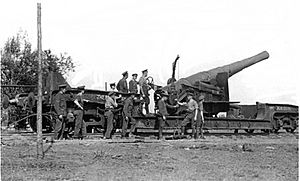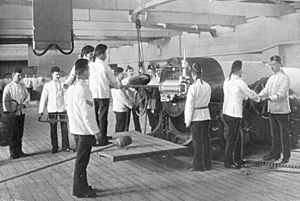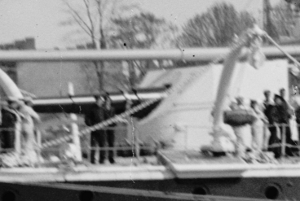BL 9.2-inch Mk I – VII naval gun facts for kids
The BL 9.2-inch Mk I–VII guns were a group of large, powerful cannons used by the British Navy and for defending coasts. They were in service from 1881 until the end of World War I. These guns were designed to fire heavy shells using gunpowder.
Quick facts for kids Ordnance BL 9.2-inch Mk I–VII gun |
|
|---|---|

Mk VI gun on disappearing mounting at Ben Buckler Gun Battery, Sydney
|
|
| Type | Naval gun Coast defence gun |
| Place of origin | United Kingdom |
| Service history | |
| In service | 1881–1918 |
| Used by | Royal Navy Australian colonies |
| Wars | World War I |
| Production history | |
| Variants | Mk I – VII |
| Specifications | |
| Mass | Mk I & II : 20 tons barrel & breech Mk III : 24 tons |
| Barrel length | Mk I & II : 230 inches (5,842 mm) bore & chamber (25 calibres) Mk III–VII : 290 inches (7,366 mm) (31.5 calibres) |
|
|
|
| Shell | 380 pounds (172.37 kg) 290 pounds (131.54 kg) (High-angle guns) |
| Calibre | 9.2-inch (233.7 mm) |
| Muzzle velocity | 2,065 feet per second (629 m/s) |
| Maximum firing range | 10,000 yards (9,100 m) |
Contents
History of the 9.2-inch Guns
These powerful guns were developed because the British Navy needed a weapon as strong as those made by other countries. In 1879, they asked for a gun similar to Germany's 24 cm (9.45 inch) gun.
Early Models: Mk I and II
The first versions, called Mk I and Mk II, were made starting in 1881. There were 19 of these guns. However, they had problems and were not used on ships.
Improved Models: Mk III to Mk VII
Later versions, from Mk III to Mk VII, were much better. These were the first ones to be placed on ships and used in real service. They were longer and more effective.
These guns were put on many important ships, including:
- Imperieuse-class armoured cruisers (Mk III)
- Orlando-class armoured cruisers (Mk V & VI)
- Blake-class protected cruisers (Mk VI)
- Edgar-class protected cruisers (Mk VI)
- Old battleships like HMS Alexandra and HMS Rupert were updated with these guns.
- During World War I, some Mk VI guns from Edgar-class cruisers were put on M15-class monitors (small warships).
Protecting Coasts: Coast Defence Guns
Many Mk IV and some Mk VI guns were used to defend coastlines. These guns were placed in special forts to protect important harbors and cities from enemy ships.
In the 1880s, engineers found a way to fire these guns at a very high angle. This made the shells drop almost straight down onto the decks of enemy ships, which were less protected than their sides. To do this, they used a lighter shell and a special wooden stick to stop the shell from slipping back in the barrel when the gun was pointed upwards. Some of these high-angle guns were placed in places like Plymouth, Gibraltar, and Singapore. Two of these guns can still be seen at Fort Siloso in Singapore.
World War I Railway Gun

During World War I, some of these large guns were put on special railway cars. This allowed them to be moved quickly along train tracks to different parts of the Western Front in France and Belgium. They were used to shell enemy positions from far away.
Australian Service
In the late 1880s and early 1890s, the Australian colonies bought 10 of the BL 9.2-inch Mk VI guns. These were special "disappearing guns" that could hide behind a wall after firing to protect themselves.
- New South Wales: Three guns were sent to protect Sydney Harbour. One went to Ben Buckler Gun Battery, one to Signal Hill Battery, and one to Steel Point Battery. The gun from Signal Hill Battery is now on display at the Royal Australian Artillery Museum.
- Victoria: Four guns were sent to Victoria to protect Port Phillip. Two went to Fort Nepean and two to Fort Queenscliff.
- South Australia: In 1888, South Australia bought two guns for a fort near Adelaide, South Australia. However, people living nearby worried about becoming a target, so the fort was never built. The British government bought these guns back in 1915.
Ammunition
Surviving Examples
You can still see some of these historic guns today:
- Two Mk IV guns are at Fort Siloso, Sentosa Island, Singapore.
- An EOC Mk VII gun (No. 7318, made in 1881) is at the Royal Australian Artillery National Museum in North Head, Sydney, Australia. It was originally at Signal Hill.
- A disappearing gun that was buried at Ben Buckler, Sydney, is waiting to be restored.
- One Mark I gun is located in Port Royal, Jamaica, at Fort Charles. It was taken out of service after an earthquake in 1907.
See also
- List of naval guns






